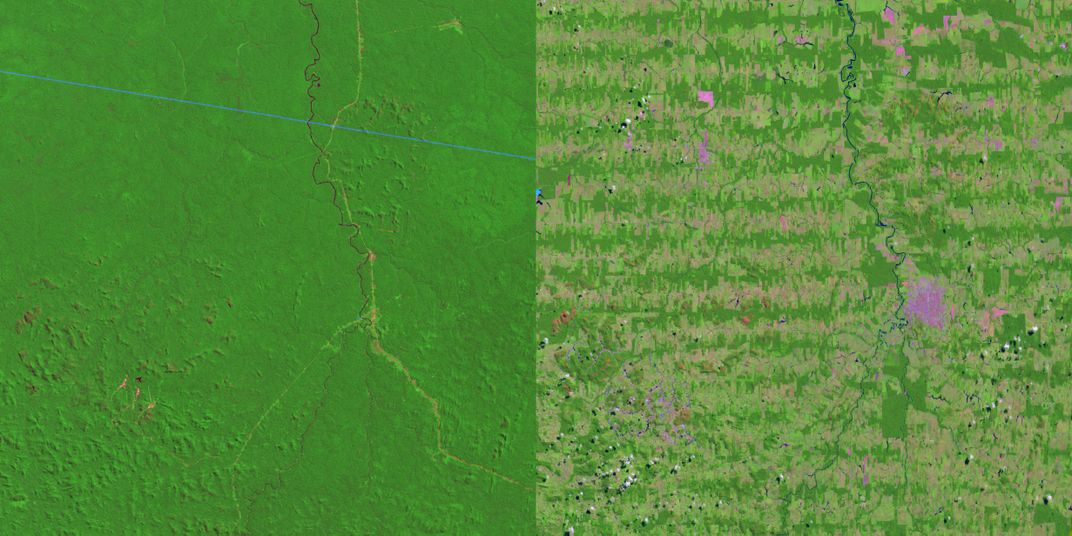What the Spread Of A Plant Mildew Tells Us About Forests
Fragmenting habitats into smaller pieces may let diseases spread more easily, a new study finds
/https://tf-cmsv2-smithsonianmag-media.s3.amazonaws.com/filer/9f/08/9f08c612-e096-4c40-9831-c6100e94ce5f/powdery_mildew.jpg)
Plants from fragmented populations may be more susceptible to disease, according to a 12-year study of a weedy herb in Finland. The findings, which appear today in Science, are somewhat worrisome given how much of the global landscape has been broken up into small, isolated pieces.
Habitat fragmentation is not uncommon. Land may be crisscrossed by roads, replaced by farm fields or towns, or drowned in the reservoirs created by hydroelectric dams. It’s easy to understand what the loss of those spaces can means for the plants and wildlife that no longer have homes—less so for the creatures and vegetation left behind in the patchy landscape.
How plant diseases spread through landscapes isn’t particularly well known; research has often focused on disease outbreaks, particularly among the agricultural crops people depend on for food. But pathogens are a natural part of the ecosystem. And scientists would like to know more about how they persist in the wild, and how human activities change things.
In the new study, Jussi Jousimo of the University of Helsinki and colleagues collected data from populations of the weedy herb Plantago lanceolata in the Åland archipelago of southwestern Finland. This area is home to thousands of populations of P. lanceolata, some of which are more fragmented and isolated than others due to the size and distribution of the islands.
Every year, a small percentage of the plants become infected with the powdery mildew Podosphaera plantaginis. The mildew is easy to spot on the leaves of the plant, and for 12 years, some 40 field assistants went out to the islands and tracked where the powdery mildew could be found among 4,000 populations of the herb.

The number of infected plants varied from year to year, from a low of 1.1 percent to as high as 16.9 percent in 2012. But overall, the mildew was more likely to infect plants from the highly fragmented areas than the highly connected ones. And when the researchers attempted to deliberately infect plants with the pathogen, their results “confirmed that resistance was significantly higher in the highly connected than in the isolated host populations,” they write.
It would seem that a pathogen should benefit from having potential hosts close together because it would be able to spread more easily through such highly connected populations. But in this experiment, the plants from those highly connected populations evolved greater resistance to the mildew, so the disease couldn’t take root.
Jousimo and colleagues speculate that there may be more gene flow between plants in these less isolated areas, which would let the plants share resistance genes. It’s also possible that these plants are living in areas of higher quality habitat and “may be able to invest more toward disease resistance than hosts growing in areas that are nutritionally limited,” they write.
“Studying infectious diseases in a metapopulation framework allows us to understand not just what permits outbreaks of infectious diseases to occur, but also the factors that determine the persistence of parasites between outbreaks,” notes Meghan A. Duff, of the University of Michigan in Ann Arbor, in an accompanying Perspectives article. Given the widespread nature of habitat fragmentation, she writes, “the results of the current study suggest that, in some cases, fragmentation might increase the likelihood of a population suffering disease outbreaks.”
With habitat fragmentation already a large contributor to the decline of species, the idea that it might also be promoting disease spread is a concern. But scientists and conservation managers have figured out how to connect some fragmented landscapes to help animal populations mix and mingle—perhaps something similar might help plants, too, survive the consequences of humanity’s growing sprawl.
/https://tf-cmsv2-smithsonianmag-media.s3.amazonaws.com/accounts/headshot/Sarah-Zielinski-240.jpg)
/https://tf-cmsv2-smithsonianmag-media.s3.amazonaws.com/accounts/headshot/Sarah-Zielinski-240.jpg)